The Allure of Untreated Natural Ruby: A Deep Dive
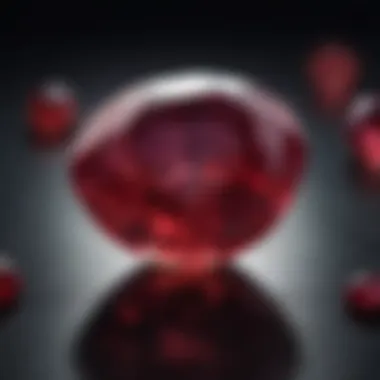
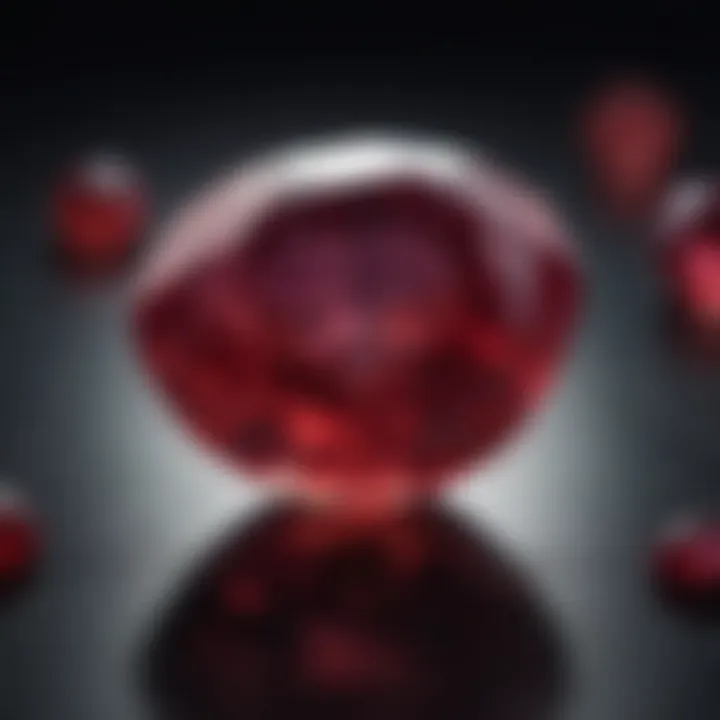
Intro
The gem industry is often cloaked in layers of treatment and enhancements, but somewhere amidst this glittery façade lies the untreated natural ruby. Understanding this captivating stone is essential for anyone with a penchant for gemstones. In this guide, we'll peel back the layers to reveal what makes untreated rubies so alluring— from their geological origins to their striking characteristics and the intricate history intertwined with human culture.
When we talk about gemstones, we're not just referring to shiny rock; we are delving into the earth's very narrative woven through time. Untreated natural rubies represent a piece of that narrative, a story of nature's artistry, untouched by human hands. So let's embark on this journey into the heart of this exquisite gemstone and uncover the treasure it truly is.
Gemstone Overview
Definition of Gemstones
Gemstones are defined as minerals and rocks that are prized for their beauty and rarity, often cut and polished for use in jewelry. However, it goes beyond mere aesthetics. These gems enchant us because each possesses a unique set of characteristics, from color and clarity to hardness and brilliance. They tell tales of the earth’s history and—more importantly— they possess value.
Untreated natural rubies are an exemplary case in point; their deep red hues are not merely the result of processing, but arise from the mineral corundum mixed with chromium. Unlike synthetic or treated stones, the creation of untreated rubies is a natural geological event that can take millions of years. This inherent beauty and rarity can make them quite desirable.
Classification of Gemstones
Gemstones can broadly be categorized into two classifications—precious and semi-precious. While the terms may imply that one is more valuable than the other, it’s important to note that market demand often dictates value as much as inherent qualities do.
- Precious gemstones: Rubies, sapphires, emeralds, and diamonds fall into this category. They are typically rarer and have higher demand.
- Semi-precious gemstones: Stones like amethyst, aquamarine, and topaz are classified as semi-precious. While beautiful, they don’t hold the same value as their precious counterparts.
Untreated natural rubies sit firmly in the realm of precious stones, and one could argue that their unaltered state only adds to their worth. But beyond classification, it's how they manage to capture the hearts of enthusiasts and collectors that truly speaks to their value.
Historical Significance
Origins of Gemstone Use
The allure of gemstones isn't something new; humans have sought them out for thousands of years. The ancient cultures recognized the intrinsic worth of colored stones, embedding them with mystical powers. From the burial adornments of ancient Egyptians to the crowning jewels of monarchs, gemstones have played pivotal roles in societal traditions.
In Southeast Asia, rubies were revered not just for beauty but were considered a symbol of wealth, power, and love. Kings and warriors sought them, believing they granted protection and invulnerability. The flows of trade between nations were often navigated through the allure of precious stones, including untreated natural rubies.
Cultural Insights: Gemstones in Ancient Civilizations
When it comes to cultural meanings, rubies were more than just adornments; they often embodied values held dear by societies. Here are some noteworthy facets of gemstone use across a few ancient civilizations:
- Ancient India: Rubies were believed to be the "king of gems". They were used in crowns and ceremonial artifacts.
- Burmese Culture: The Burmese warriors embedded rubies into their skin, believing that the stones would grant them strength in battle.
- Mayan Civilization: Similarly, the Mayans revered rubies, associating them with the blood of their gods.
The cultural significance of rubies therefore transcends their monetary value, enveloping them in layers of history, tradition, and mystique.
The beauty of an untreated natural ruby is not just in its appearance; it reflects centuries of human stories, struggles, and aspirations, encapsulating the very essence of nature's artistry.
In the journey ahead, we’ll explore the distinctive characteristics of untreated natural rubies, their care, and the crucial differences that separate them from treated counterparts. This understanding paves the way for informed choices, whether for personal adornment or collection.
Understanding Untreated Natural Ruby
Understanding untreated natural ruby is fundamentally important in appreciating its unique beauty and value. This section lays the groundwork for the rest of the article, offering insights into what separates untreated rubies from their treated counterparts, why these differences matter, and how geological processes contribute to the enamel-like quality of this precious gemstone. The allure of untreated rubies goes beyond mere appearance; it speaks to authenticity, rarity, and a geological history that resonates with both collectors and jewelry designers alike.
Defining Untreated Natural Ruby
Untreated natural ruby, at its core, is defined as a gemstone that has not undergone any artificial enhancements or modifications during its preparation for market. Unlike treated rubies, which may have undergone processes like heat treatment or dyeing to improve color and clarity, untreated rubies remain untouched, preserving their natural state. This preservation is significant not just for aesthetic value but also for the authenticity sought by gemstone enthusiasts.
The Geological Formation of Ruby
The geological genesis of rubies is fascinating and essential for a comprehensive understanding of the stone. Natural rubies are formed under high temperatures and pressures in the Earth’s crust, primarily composed of the mineral corundum. Several key elements provide depths to our understanding:
Mineral Composition
The mineral composition of ruby, predominantly aluminum oxide, is a vital aspect of its identity. This specific mineral gives it not only its hardness, rated 9 on the Mohs scale, but also its vibrant colors, which can range from deep red to purplish tones. This hardness makes ruby a popular choice for jewelry worn daily, ensuring longevity and resilience.
Ruby's mineral composition is enriched by trace elements such as chromium, which enhances its vivid red color. Because untreated rubies maintain this original composition, they often fetch higher prices in markets compared to treated ones. However, impurities found in some specimens can also affect their value and clarity, making the buyer’s choice a balancing act of desirability versus authenticity.
Crystallization Process
The crystallization process of ruby is equally captivating, taking place over thousands of years under intense pressure and heat. This process causes the aluminum oxide to undergo changes, ultimately forming the crystalline structures that we recognize as rubies today. The results of this ancient process are striking gemstones with a wide range of clarity and color saturation.
There’s a distinct beauty in knowing that each untreated ruby captures a moment in Earth’s history. Some rubies exhibit unique inclusions or characteristics borne from their journey, making each piece a narrative of natural artistry. However, while such features are valued, they can also present challenges in terms of clarity, an important factor in assessing the gem’s worth.
Geological Locations
Geologically, rubies are found in several key locations around the globe—most notably in Myanmar, Thailand, and Madagascar. Each of these sites offers distinct characteristics that influence the rubies mined there. For instance, Myanmar rubies, known for their rich color and brilliance, are often considered the benchmark for quality.
The geographic origins of rubies add another layer of allure. Different locations can produce rubies with unique qualities and color variances, giving collectors a treasure hunt of sorts as they search for the most coveted pieces. However, sourcing rubies from reputable areas requires thorough research and understanding of market dynamics to ensure authenticity and value retention.

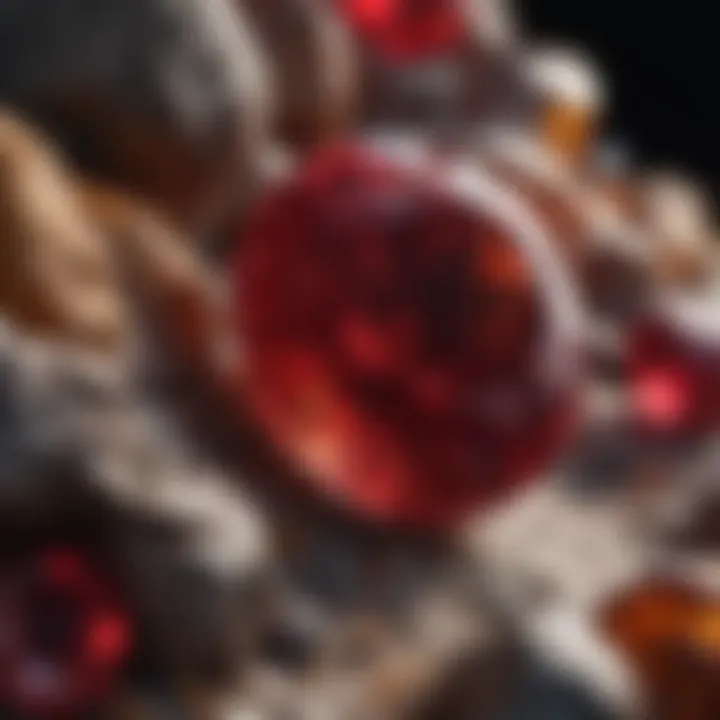
"An untreated ruby is like a time capsule of Earth’s creativity; its beauty lies in its natural form—untouched and unaltered."
In sum, the understanding of untreated natural ruby encompasses not just its definition but dives deep into its geological formation, mineral composition, crystallization process, and the geographical influence on its quality. By recognizing these factors, enthusiasts can appreciate the distinctive charm of untreated rubies and their significant role in both personal collections and the broader gemstone market.
Characteristics of Untreated Natural Ruby
The beauty of untreated natural ruby lies not just in its vibrant hues but in its distinct characteristics that set it apart from other gemstones. Understanding these characteristics can elevate one’s appreciation and guide responsible purchasing. Each aspect, whether it be color, clarity, or cut, plays a pivotal role in defining the allure of this precious stone.
Color Variations and Their Significance
Color Ranges
Color is arguably the most striking feature of natural ruby. The range of colors in untreated rubies can span from deep blood-red, which is considered the most desirable, to light pink hues. The intensity of red is influenced by the presence of chromium. A ruby that exhibits a vivid, almost glowing red is not just visually appealing; it’s also likely to fetch higher prices in the market.
The appeal of these color ranges comes not only from their aesthetic allure but also from what they signify culturally and emotionally. Red, often associated with love and passion, makes ruby a popular choice for significant gifts.
However, the nuances in color also have a downside. Variants that lean too close to pink may not be valued as highly in the market. Thus, while a broad color spectrum exists, it is worth recognizing those that hold greater significance.
Impact of Impurities
Natural rubies are rarely perfect. Impurities play a significant role in influencing both the character and value of the stone. For instance, the presence of iron can temper the vividness of the ruby, shifting its color towards a more brownish hue. Such variations might reduce appeal for those seeking that classic red aesthetic.
Yet, impurities can also enhance the uniqueness of a stone. Some collectors may even find beauty in the imperfections, choosing rubies that tell a story through their inclusions. They add personal character, which could be seen as a form of natural artistry. However, it's essential to balance this unique charm against the potential decrease in value, as most buyers usually prefer cleaner stones.
Clarity and Cut Quality
Understanding Clarity Grades
Clarity is another key determinant of a ruby's overall allure and value. When evaluating clarity, gemstones are graded on the visibility of internal flaws or inclusions. An untreated ruby with high clarity radiates light beautifully, creating an appeal that captivates onlookers.
The grading scale commonly ranges from "Included" to "Flawless." Most enthusiasts and collectors favor rubies with clarity grades of “Very Slightly Included,” as they not only appear stunning but also represent a balance of quality and affordability. Collectors should note the clarity's interplay with overall aesthetics because a visually striking ruby can sometimes outweigh minor inclusions.
Importance of Precision Cutting
Precision in cutting is fundamental to enhancing a ruby’s inherent qualities. Well-cut rubies can maximize light reflection and refraction, essentially making the stone come alive. A poorly cut ruby can dull its natural brilliance, overshadowing its color potential.
When evaluating cut quality, consider the proportions and symmetry of the gem. An expertly crafted ruby can show a play of light that does justice to its color vibrancy. Investing in precision-cut stones often translates to a greater overall satisfaction in wearability and visual impact - it's simply worth it.
The Role of Transparency
Transparency in natural rubies can significantly affect their desirability. Unlike other gemstones, rubies are often sought after for their rich colors rather than complete transparency. This distinct feature contributes to the overall visual appeal of the gemstone.
Translucent rubies, while not completely transparent, can still exhibit stunning color depth. This can create an enchanting glow, especially under certain lighting conditions. While most buyers might lean toward transparency, the allure of an opaque yet colorful ruby shouldn't be underestimated. The depth of color and the story behind each stone often outweighs clarity alone.
"In the world of gemstones, it’s the blend of color, clarity, and cut that ultimately captures the heart of the beholder."
Understanding these characteristics provides a deeper appreciation for untreated natural rubies. Each stone, with its own unique tale, beckons gem enthusiasts and collectors alike to delve deeper into its precious narrative.
Historical and Cultural Significance
Understanding the historical and cultural significance of untreated natural ruby helps illuminate its value beyond mere aesthetics. Throughout the ages, rubies have captured human imagination and admiration. They were not just gemstones to many cultures but held deeper meanings and associations that shaped their place in society. This section brings to light how these dazzling stones have interwoven into the fabric of different civilizations, reinforcing their status as precious jewels with stories to tell.
Ruby in Ancient Civilizations
Symbolism in Different Cultures
In many cultures, ruby was seen as a powerful stone, often linked with the heart and associated with eternal love. For example, in ancient India, rubies were considered the "king of gems" and were believed to confer wealth, health, and even protection against evil spirits. This deep-seated reverence stems from the vibrant red hues that symbolize the life force, akin to blood flowing through the veins. The symbolism of rubies varied globally; in some cultures, they were thought to bestow courage and wisdom upon the wearer.
Another unique aspect is how rubies were believed to influence the emotional state of individuals. In medieval Europe, they were seen as talismans against misfortune, believed to bring powerful vibes of happiness and peace, hence their prominent display in regalia of royalty. This cultural backdrop reinforces the ruby's allure as not merely a gemstone but as a symbol with significant emotional embrace.
Historical Uses and Artifacts
The historical uses of rubies are fascinating. They have been fashioned into various artifacts, with the most notable being crowns and royal ornamentation. The famed Imperial State Crown of England features rubies that date back centuries, linking the gemstone to the heritage of power and nobility.
Moreover, ancient artifacts, such as the Burmese rubies, were believed to have healing properties. Such historical notions reflect how rubies were integrated into rituals and traditions, often placed in burial sites to accompany the deceased into the afterlife, showcasing their significance in both life and death. This practice shows the advantage of the ruby's enduring legacy, fostering its connection not only with beauty but also with a spiritual journey.
Modern Day Perceptions
Contemporary Value
Today, the value of untreated natural rubies extends beyond their looks. In modern times, they are not only regarded as high-value collectibles but also as investments. The move toward embracing natural gemstones is crucial, as society has started valuing authenticity over artificially treated stones. This shift has ramifications on market demand as consumers are increasingly seeking untreated rubies, making them a more sought-after commodity.
The unique feature of untreated rubies lies in their rarity. They are harder to come by, which translates into a higher premium in today's market.
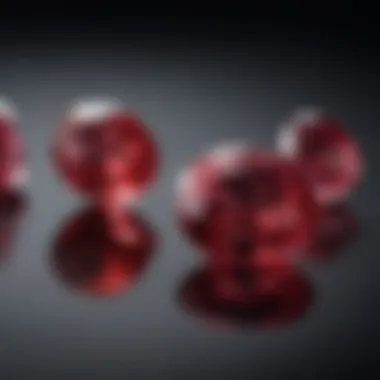
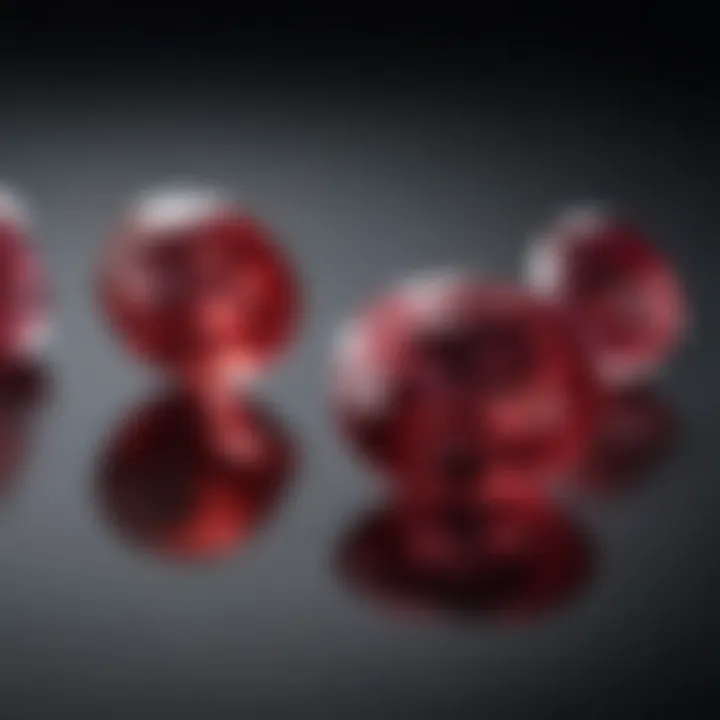
Celebrity Influence
The influence of celebrities on the appeal of untreated rubies cannot be understated. Figures like Rihanna and Elizabeth Taylor have sported stunning ruby jewelry pieces, significantly boosting its popularity among fans and collectors alike. When high-profile figures flaunt natural rubies, it sends a strong message about the aesthetic and emotional value of these gems in contemporary society. This celebrity endorsement can create trends that influence purchasing decisions, making it a powerful aspect of modern culture.
These unique characteristics of ruby in the present-day landscape show how the gemstone is not just a fashion statement but a part of a greater narrative that resonates with those who value heritage, authenticity, and emotional connection.
Market Dynamics and Value Assessment
In the world of gemstones, understanding the market dynamics and how value is assessed is critical for both collectors and enthusiasts. Untreated natural ruby holds a distinct place in this market, setting itself apart not only due to its inherent beauty but also because of the economic factors that influence its pricing and desirability.
Comparison with Treated Rubies
Defining Treatments
The term "treatment" in the context of gemstones refers to any kind of enhancement done to improve their appearance. For rubies, treatments can range from simple techniques like oiling to more advanced methods that involve heating or even chemical treatments. One key characteristic of these treatments is that while they can enhance color and clarity, they may also impact the gem's overall value. For our discussion, it's essential to highlight that untreated natural rubies, devoid of any enhancements, are often perceived as more valuable because of their rarity.
Interestingly, untreated rubies are often marketed as being more "authentic"—a sentimental connection buyers feel to a stone that hasn’t undergone manipulation. This perception can enhance their desirability among certain collectors.
Price Differentiation
Price differentiation is a significant aspect when evaluating untreated versus treated rubies. Treated rubies generally have a lower market value due to their enhanced nature; buyers know that enhancements can be a slippery slope. A well-treated ruby may still fetch a good price, but it won’t match the premium associated with untreated gems. It's important to note, though, that certain treatments have gained popularity, especially if they yield beautiful results without compromising the stone's integrity substantially.
In this case, the key feature of price differentiation becomes the understanding of long-term investment. Untreated natural rubies tend to appreciate better over time, making them a sound option for those wishing to invest.
Market Trends and Demand
Emerging Markets
Examining the realm of emerging markets can give insights into current trends for untreated rubies. Countries where affluence is on the rise often see an increase in demand for luxury goods, including gemstones. As these countries develop more robust economies, their citizens often look to invest in high-value items, which positions untreated rubies as a status symbol. This dynamic can create competition within the market, thus driving prices upward. The allure of natural beauty coupled with cultural significance often ties into this increased demand.
Another notable facet of emerging markets is their ability to dictate trends that can ripple across the globe; when a region becomes enamored with a specific style or type of ruby, it can influence perceptions and purchasing behaviors elsewhere.
Investment Potential
When we delve into investment potential, untreated natural rubies shine brightly. Unlike other gemstones, their allure isn’t solely linked to their aesthetics but also their capability to serve as a form of investment. The rarity factor plays a huge role here; as supplies dwindle and demand grows, these rubies tend to retain their worth, sometimes even appreciating significantly.
The unique feature of investing in untreated natural rubies lies in the understanding that while market trends can fluctuate, the true allure lies in their untouched form. These gems offer the promise of future value coupled with the satisfaction of owning a piece of nature's artistry, making them a compelling choice for seasoned investors and newcomers alike.
Ultimately, evaluating the dynamics of the market and recognizing the value of untreated natural rubies leads to a better understanding of how to navigate the gemstone landscape effectively.
Buying and Caring for Untreated Natural Ruby
When it comes to the purchase of untreated natural ruby, understanding how to choose and maintain these precious stones is crucial. The charm of an untreated ruby lies not just in its vivid color and clarity but also in the story it tells about nature's artistry. A well-informed buyer understands that a more natural gem often requires greater care, both in terms of selection and long-term maintenance.
Guidelines for Selecting Quality Gems
Certification Importance
Certification plays a vital role in the world of gemstone buying. Without a proper certification, you might as well be tossing darts in the dark. A reliable certificate guarantees the gem's authenticity, confirming it is both untreated and of natural origin. This means that it has not undergone any enhancements that could potentially alter its appearance and, more importantly, its value.
A key aspect of certification is that it provides an objective assessment of the gemstone’s quality. These documents come from reputable gemological laboratories and include details about the ruby's color, clarity, and even its origin. Because of this, it is a highly beneficial choice for anyone looking to purchase untreated rubies.
However, keep in mind that not all certificates are created equal. The reputation of the issuing lab can greatly affect the perceived value of the stone.
Reputable Sellers
The importance of purchasing from reputable sellers cannot be overstated. Just like you wouldn’t buy a fancy painting from a street vendor without checking its provenance, the same applies to rubies. Authentic sellers provide assurance that their gems are genuine and come with the right certification. This makes for a safer purchase.
A good seller will also be transparent about the sourcing of their stones, combining ethics with quality assurance. When you find a seller who specializes in natural gemstones, you can trust that you’re getting a quality product. Their expertise will often include guidance on the care required for maintaining the stone's exquisite appearance over the years. However, be cautious; even reputable sellers may occasionally have discrepancies. Always conduct your own research.
Proper Care and Maintenance
Cleaning Methods
Caring for untreated natural ruby is an essential part of preserving its allure over time. One common method involves using mild soap and lukewarm water to clean the stone. It’s beneficial because it removes dirt without scratching the surface. A soft-bristled brush can be used for intricate settings. This method is popular among collectors who want to maintain the ruby’s vibrance without causing any harm.
However, avoid using harsh chemicals as they may damage the stone's integrity. Keeping the ruby clean not only enhances its appearance but also can help in spotting any natural flaws or damage that might need addressing.
Storage Recommendations
The way you store an untreated ruby can greatly impact its longevity and beauty. Ideally, rubies should be kept in a soft cloth pouch or lined jewelry box to prevent scratches from other gemstones. It’s crucial to store them separately, as rubies can be harder than many other gems and could inadvertently scratch them.
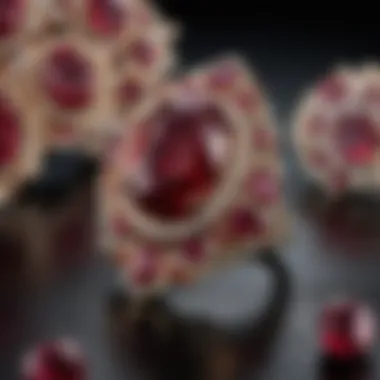
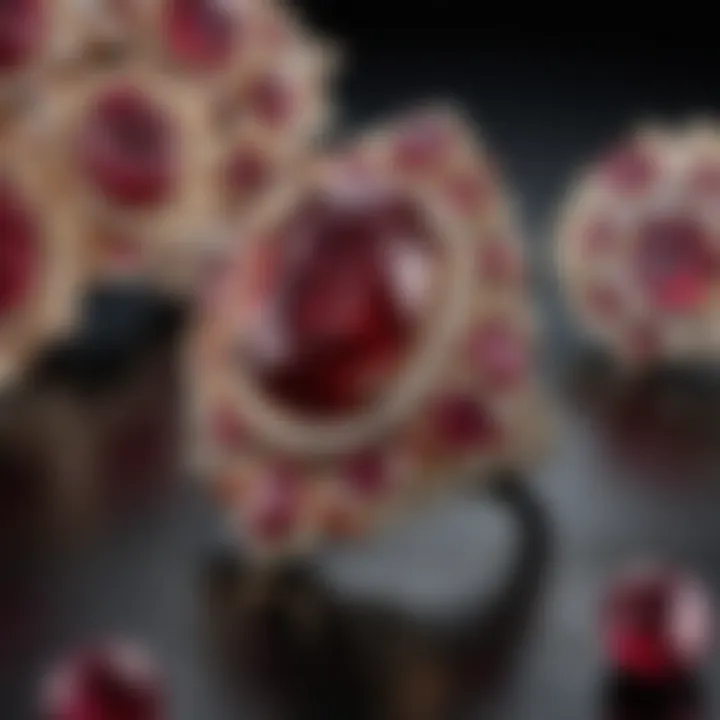
A special feature of proper storage is that it helps preserve not just the physical condition but also the emotional connection to the stone. When cared for properly, the ruby can stay in excellent condition, passing down through generations as a treasured heirloom.
Metaphysical Properties of Ruby
Ruby, with its vivid hues and robust composition, is not just prized for its physical beauty; it carries significant metaphysical properties as well. In this section, we delve into the spiritual and healing dimensions of untreated natural ruby. These properties often attract gemstone enthusiasts and collectors, providing a bridge between the tangible and intangible aspects of this remarkable stone.
Spiritual Significance
Emotional Benefits
The emotional benefits associated with ruby are often celebrated among holistic practitioners. This gemstone is believed to promote feelings of love, joy, and emotional vitality. When individuals adorn themselves with untreated ruby, it's as if they're wrapping themselves in a cloak of warmth and positivity. This warmth facilitates both self-love and the conveyance of love to others, making it a popular choice for those who are nurturing their relationships.
One standout feature of ruby’s emotional benefits is its supposed ability to enhance motivation and encourage passion. Many people find that wearing ruby encourages a can-do attitude, pushing them to pursue their goals with fervor. It's a stone that embodies vitality—a reminder that emotions can fuel action, propelling one toward lifelong aspirations. On the flip side, there's a caution to consider as well. Some might experience intense emotions that could overwhelm them. This is where personal reflection comes into play, ensuring that the emotional wave ruby generates aligns with one's mental state and intentions.
Symbol of Love and Passion
Ruby is often referred to as the "stone of love and passion" because of its rich connections to Romantic era symbolism, especially in the context of deep emotional bonds and marital unions. It embodies the essence of passion and intimacy, making it a cherished gemstone for engagement rings and other romantic gifts. This connection adds a layer of allure as couples seek to express their love in the finest fashion.
A key characteristic of ruby as a symbol of love is its deep red color, which has been historically associated with the heart. This connection to blood and vitality makes it an apt representation of true love—adventurous, bold, and unyielding. However, such passionate potency may pose a certain risk; if relationships are troubled, the powerful energy of ruby could amplify the existing tensions. Thus, while it is a beautiful symbol of passion, it requires a mindful approach, where one balances its fiery nature with calm reflection.
Healing Properties
Physical Claims
Beyond its emotional implications, ruby is also regarded for its alleged physical healing properties. Practitioners of crystal healing often assert that ruby promotes circulation and can assist in detoxifying the body. Many still believe it has the power to improve vitality and energy levels, leading to enhanced physical health overall.
What sets ruby apart in the realm of physical healing is its purported ability to stimulate the body’s life force energies. This unique feature is thought to resonate with one's core vitality, providing not just energy but also a sense of grounding. Yet, it’s important to approach these healing claims critically. While anecdotal evidence abounds, scientific backing is scarce, and individuals are advised to consult professionals for health issues instead of relying solely on gemstones.
Psychological Effects
The psychological effects associated with ruby are equally fascinating. Many believe that having this gemstone nearby can aid in countering negative thought patterns, anxiety, and feelings of emotional instability. It is thought to foster clarity and determination, which can be highly beneficial for someone grappling with their mental health.
One distinct psychological advantage it offers stems from its reputation for fortifying inner strength. By enhancing self-confidence and self-awareness, ruby can encourage individuals to confront their fears. This transformative potential makes it an appealing choice for those on a journey toward emotional and mental wellness. However, like its emotional benefits, individuals should approach its use with an open mind while being mindful of their individual experiences.
Overall, the metaphysical properties of ruby present a compelling narrative that intertwines physical charm with deeper spiritual dimensions. As passions ignite and emotions are amplified, those who choose these gemstones can tap into a world that transcends mere aesthetics—inviting a richer quality into their lives.
Common Misconceptions About Untreated Rubies
Understanding the intricacies of untreated natural rubies is not simply an exercise in gemstone appreciation; it's a journey into the heart of how these magnificent stones are often misrepresented. Misconceptions abound in the world of rubies, especially concerning their authenticity, value, and treatment methods. Addressing these misunderstandings is vital for enthusiasts and collectors alike. By clarifying these points, we not only enhance our knowledge but also make informed decisions about purchases and collections.
Debunking Myths
Natural vs. Synthetic Confusion
The confusion between natural and synthetic rubies is one of the more prominent misconceptions in the gem world. Many people mistakenly assume that all rubies on the market are natural or that synthetic rubies hold the same value. In reality, natural rubies are formed through geologic processes over millions of years, while synthetic ones are created in laboratories, often in a matter of weeks.
This distinction greatly impacts both the market and buyer perception. Natural rubies, with their intrinsic uniqueness, carry stories of their origin that synthetic stones simply cannot replicate. These natural gems are usually preferred by collectors due to their rarity and perceived value. Moreover, natural rubies often possess inclusions and imperfections that add to their character, something that synthetic options lack.
Benefits of understanding this difference include making educated purchases and ensuring that one's collection reflects genuine pieces. Collectors can avoid potential pitfalls associated with overspending on synthetic alternatives, which may not yield the same long-term value.
Myths about Value
When it comes to the value of untreated natural rubies, several myths contribute to widespread misconceptions. Some individuals believe that untreated rubies are always more expensive than treated counterparts. However, while untreated rubies generally command a higher price due to their rarity and purity, factors such as size, color, and clarity also play significant roles in determining value.
Additionally, the notion that all untreated rubies are inherently superior is not universally true. Certain treatments can enhance the visual appeal of rubies without compromising their quality, thus leading to price points that might surprise buyers unaware of these nuances.
It’s crucial for enthusiasts to recognize that while untreated rubies are considered more desirable by many collectors, this does not automatically translate to a straightforward comparison of worth across all specimens. Factors like market trends, personal preferences, and rarity should all be taken into account when assessing the value of a ruby.
"Understanding these common misconceptions can empower collectors to make astute choices, ensuring that each addition to their collection is both valuable and genuine."
Being informed about these myths allows buyers to approach the market with confidence, avoiding missteps that can lead to financial losses or dissatisfaction with their purchases. By grounding our understanding in facts rather than folklore, we can truly appreciate the depth and allure of untreated natural rubies.
Finale: Embracing the Natural Beauty of Ruby
In navigating the world of untreated natural ruby, we step into a realm rich with intrinsic value and historical significance. This conclusion invites one to reflect deeply on what makes this gemstone more than just a sparkly adornment. Beyond its beauty lies a narrative of geological formation, cultural lore, and personal connection that resonates with gemstone enthusiasts, collectors, and jewelry designers alike.
Understanding and appreciating untreated natural ruby involves recognizing its unique characteristics. Each stone tells a story etched by nature itself, showcasing color variations that reflect the mineral's origin, as well as imperfections that add to its charm. The allure here is not just in the visual appeal but in the authenticity of the gem, ensuring that every piece bears the hallmark of time and earth’s artistry.
The Timeless Appeal
The timeless appeal of untreated natural ruby goes hand in hand with its emotional resonance. For centuries, cultures across the globe have held rubies in high esteem, often associating them with nobility, love, and protection. Their vibrant hues are not only visually striking but are also believed to convey passion and energy.
- Emotional Connection: Many collectors and wearers appreciate how these raw gems can evoke feelings. When one wears an untreated ruby, it’s not merely about fashion; it’s about wearing a piece of history enriched with personal significance.
- Investment Potential: As more people become aware of the differences between treated and untreated stones, the demand for natural rubies has seen an uptick. This creates an opportunity for collectors to invest in gemstones that are likely to appreciate over time.
"A ruby that has stood the test of time bears witness to the stories of those who cherished it before us."
- Craftsmanship and Design: For jewelry designers, untreated rubies are a canvas, inviting innovative designs that celebrate natural beauty. The challenge lies in incorporating these gems into pieces that showcase their raw elegance while enhancing their innate properties.
Embracing the natural beauty of ruby means recognizing its value as not only an artistic object but also a personal treasure. With careful selection and responsible purchasing, collectors can ensure they are acquiring gems that continue to tell their age-old tales, filled with the mysteries of the earth and the hands that once held them.



